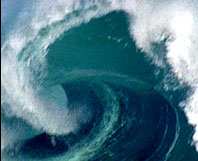
|

|
|

|

|

|

|

|
Hi! My name is Kaylina Huang. I am a 7th grader at Myron B. Thompson Online Academy
in Hawaii. Welcome to my Science Project about Tsunamis. Please bear with me, this is my first time creating
web pages. Here I will be going over just what a tsunami is and
what effects it has on people and their lives. I will also talk about some specific tsunamis that occured and how it affected
the people and their communities. And lastly I will discuss some of the ways that the effects of a tsunami can be minimized.

What is a Tsunami?
The word tsunami is a Japanese word which means harbor wave. A tsunami is defined as a series
of ocean waves that are of very long length usually caused by an underwater earthquake. A tsunami can occur at any time, day
or night. However, not all earthquakes are the cause of tsunamis. Sometimes a tsunami can be generated by volcanic eruptions,
landslides, underwater explosions, or even the impact of a meteorite or comet.
Tsunamis evolve through 3 stages: generation,
propagation, and inundation. The seafloor
disturbances, such as motion along a fault, push up the overlying water. The wave then propagates(multiplies) across
the deeper part of the ocean at speeds equivalent of a jetliner. However, with a length up to 600 times its own height, the
wave's slope is often too gentle to notice. Once it enters shallow water, the wave starts to slow down to highway speeds and
it sometimes runs ashore as a tide like flood. Other times, refraction and shoaling funnel the wave's energy into a dangerously
high wall of water, it then slows down and is overtaken by the wave behind, or wraps around a headland.
You can tell the difference between tsunami waves from ordinary surf waves by their great
length. They often exceed 100 miles into the deep ocean, and by the long amount of time between successive peaks, 5 minutes
to an hour. A tsunami can exceed 500 MPH in the deep ocean but slows to 20 or 30 MPH in the shallow water near land. In less
than 24 hours, a tsunami can cross the entire Pacific Ocean.
NEXT
|

|

|

|

|

|
|

|

|

